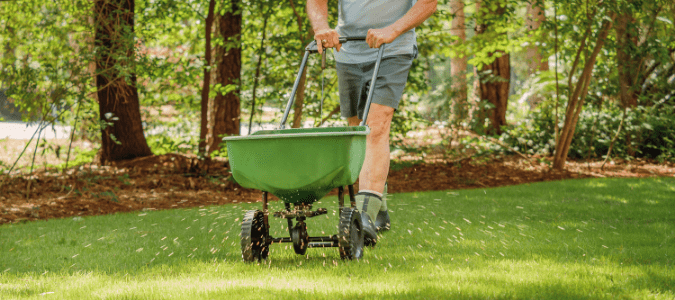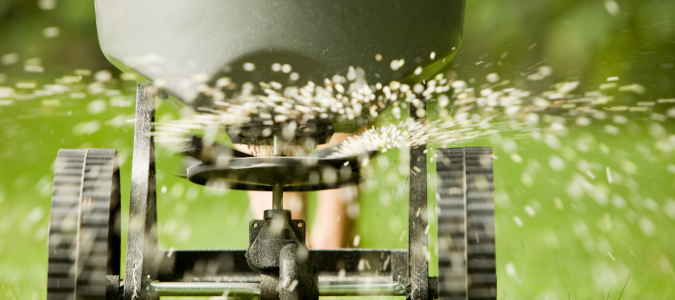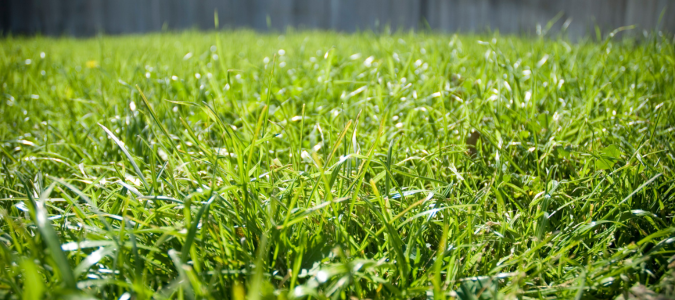Do you know how to spread fertilizer? This is something that is useful for a homeowner to know, but it’s also something a professional can do if you don’t want to spend your weekend spreading fertilizer.
Tips To Prepare for Fertilization
Proper lawn fertilization is important for maintaining a lush, beautiful lawn. However, many homeowners don’t know how to properly spread fertilizer. Once you learn the correct steps, you’ll find that spreading fertilizer doesn’t have to be an overwhelming task.
The first step is choosing the right fertilizer for your lawn’s needs. Factors to consider include the type of soil you have, the species of your grass, and any nutrient deficiencies or pH balances you need to address.
Additionally, some fertilizers are specifically formulated to control weeds or improve the health of your soil. If you aren’t sure what type of fertilizer or how much fertilizer you should use for your lawn, a lawn care specialist can fertilize your lawn for you.
Once you select your fertilizer, you will need to gather the right spreading tools. There are multiple ways to spread fertilizer, but the most common tools are drop spreaders and broadcast spreaders.
Drop spreaders evenly distribute fertilizer in a smaller radius but present challenges for complete coverage, while broadcast spreaders disperse fertilizer across a wider area of your lawn. Broadcast spreaders are more thorough when it comes to coverage, and works quicker than drop spreaders. However, there are times when you need a more controlled fertilization method, which is when drop spreaders are handy.
The third step is to prepare your lawn before you start fertilizing. Watering your lawn a few days before you plan to fertilize it is a good idea to help it absorb moisture and nutrients more efficiently. Then, your lawn will absorb the fertilizer better, making your efforts more effective. Some fertilizers should be watered immediately after applying.
You should also mow your lawn one to two days before fertilizing it so that the grass is uniform in height. This will encourage the grass to grow evenly after fertilization. Shorter grass gives the fertilizer better access to the soil.
How To Spread Fertilizer on Your Lawn
After following the preparation tips above, you are ready to fertilize your lawn. Follow these steps to spread fertilizer on your lawn:
- Prepare your spreader by choosing the right setting based on the manufacturer’s recommendations and your lawn’s needs. There are limits on how much fertilizer to apply to any given area within a year’s time. Most fertilizer formulations are designed to deliver a specific amount of a particular nutrient in measurements of pounds per 1,000 square feet. On average, you should not exceed 3 pounds of fertilizer over 1,000 square feet of total fertilizer per application and shouldn’t exceed 12 pounds of fertilizer per year in 1,000 square feet.
- Start fertilizing at the perimeter of your lawn and work inwards. To spread the fertilizer evenly, walk in straight lines and overlap rows to ensure you fertilize the entire lawn.
- Maintain a consistent walking pace that is not too fast or slow.
- Watch out for trees, shrubbery and flower beds. You may need to adjust the settings on your spreader to fertilize hard-to-reach areas. Over applying fertilizer can damage your lawn and even lead to dead areas.
- If fertilizer accidentally spills onto your sidewalk or driveway, use a broom or leaf blower to move it back toward your lawn to avoid runoff into storm drains.
Once you get used to the process, you will master spreading fertilizer on your lawn. However, if you’d rather not risk over or under applying or spend your weekend fertilizing your lawn, a lawn care specialist can offer advice and tackle this chore for you.
Liquid Lawn Fertilizer Versus Granular Lawn Fertilizer
What’s the difference between liquid lawn fertilizer and granular lawn fertilizer? Many homeowners ask this question when they are navigating fertilizing their lawns. The options for fertilization methods can seem endless, so it’s normal to feel overwhelmed.
Liquid Lawn Fertilizers
The most important thing to know is that liquid lawn fertilizers are often concentrates that are diluted with water and sprayed onto lawns. Granular lawn fertilizer, on the other hand, is dry and typically comes in the form of pellets.
Each type of fertilizer has several advantages and disadvantages, and which one is right for your lawn will depend on its needs.
For example, liquid fertilizers have fast absorption rates, which offer quick results. They also offer proper fertilizer distribution since they are sprayed evenly over the lawn. There are a number of liquid fertilizer formulas, so you can choose one based on your lawn’s specific needs. They can be great quick fixes for nutrient deficiencies. Be sure to follow the mixing and application directions on the fertilizer label.
The downside to liquid fertilizers is that they require more frequent applications. This is because they absorb so quickly. Additionally, rainwater can wash away the fertilizer.
If you aren’t experienced with applying liquid fertilizer, it can be easy to accidentally overapply it. Lastly, liquid fertilizers require more equipment than granular fertilizers, which can make it a more costly fertilization method.
Granular Lawn Fertilizer
The main advantage of granular fertilizer is that it releases slowly over time, so you don’t have to fertilize your lawn as often. There is also no risk of granular fertilizer spilling or leaking, and it’s easier to store than liquid fertilizer.
Next, granular fertilizer is easy to apply and requires fewer tools than liquid fertilizer, and there is less risk of nutrient runoff.
Next, since granular fertilizer releases slowly, it can take longer to see results than it does with liquid fertilizers. There are also fewer formulation options, which makes it harder to customize your fertilization efforts to your lawn’s needs.
Since both types of fertilizer have their advantages and disadvantages, the correct choice depends on your lawn’s needs, your desired maintenance schedule and other factors such as weather.
If you aren’t sure whether liquid lawn fertilizer or granular lawn fertilizer is right for you and your lawn, consult with a lawn care specialist for advice.
When To Fertilize New Bermuda Sod
Are you wondering when to fertilize new bermuda sod? Bermuda grass is popular in Texas and other southeastern states because of its resilience to high temperatures. This warm season grass is also loved for the beautiful and lush green lawns that it produces.
Fertilization is an important component of keeping bermuda grass healthy, especially new bermuda sod that is just beginning to develop a root system. The most important factor to get right is the timing of the fertilization. If you fertilize new bermuda sod before it’s had a chance to take root, you will stress the grass and prevent it from growing a strong root system.
Wait until your bermuda grass has developed roots to fertilize it for the first time. This typically happens between four to six weeks after planting, but that will depend on several environmental factors, such as soil type and watering frequency. Bermuda grass should be fertilized at least two times during the growing season—once in May and again in September.
If you aren’t sure how or when to fertilize new bermuda sod, contact your local lawn care specialist.
Tips to Keep Bermuda Grass Healthy
Fertilization is only one part of maintaining healthy bermuda grass. It’s also important to follow the proper watering, mowing and maintenance protocols.
Bermuda grass must be watered deeply in order to keep the roots moist and healthy. Your watering schedule is especially important during the hot summer months.
Next, bermuda grass should be kept at a height of one and a half to two inches tall. Mowing your bermuda grass routinely will help it grow denser and prevent thatch buildup.
Be careful that your bermuda grass does not get too much shade. This type of grass thrives with six to eight hours of direct sunlight every day, so it’s important to trim back trees that may block the sun from reaching your grass for that amount of time. Additionally, structures like pergolas can also block the sun.
Aerating bermuda grass on occasion can help avoid soil compaction and improve air and water penetration, which is important for healthy root growth.
Finally, make sure you are proactive about weed and pest management, as they can both damage bermuda grass. Preventative maintenance and treatments can go a long way in limiting these problems.
For more tips on how to maintain your bermuda grass, work with a lawn care specialist. They can handle the maintenance so you can free up your time or simply offer advice on proper fertilization and maintenance methods.
Maintain a Healthy Lawn With Professional Assistance
As a homeowner, it’s normal to desire a healthy and beautiful lawn, but you might not know how to achieve those results yourself.
While there are many lawn maintenance techniques you can learn to do on your own, working with a lawn care specialist is the best way to ensure success. They can provide the best products and treatments, and create a maintenance schedule to keep your lawn healthy and beautiful.
ABC Can Keep Your Lawn Healthy and Green
Taking care of your grass can take a lot of work. If you would rather spend your weekend enjoying your yard, contact ABC Home & Commercial Services. Our lawn care team can give you that healthy green grass you’ve been looking for. We even have a team who can refresh your landscaping!



